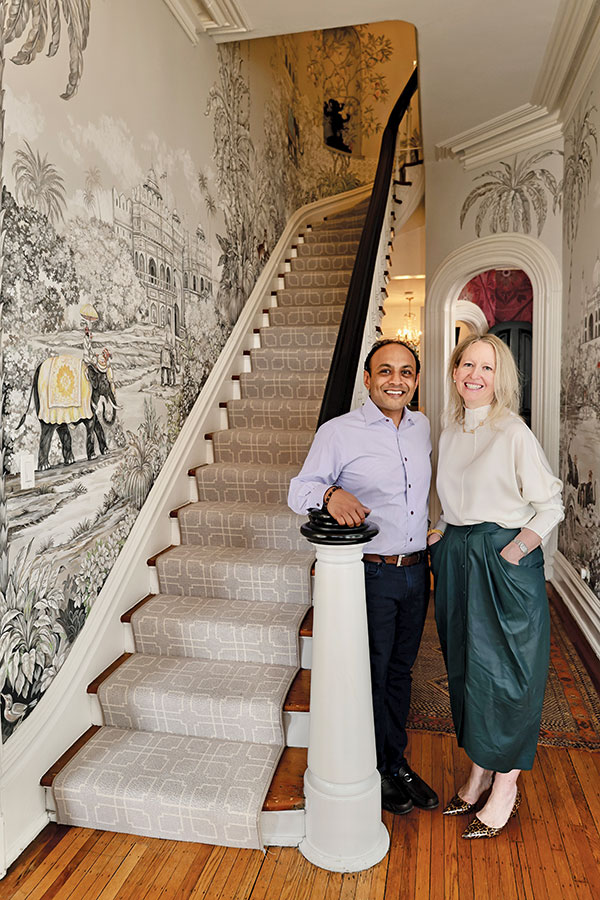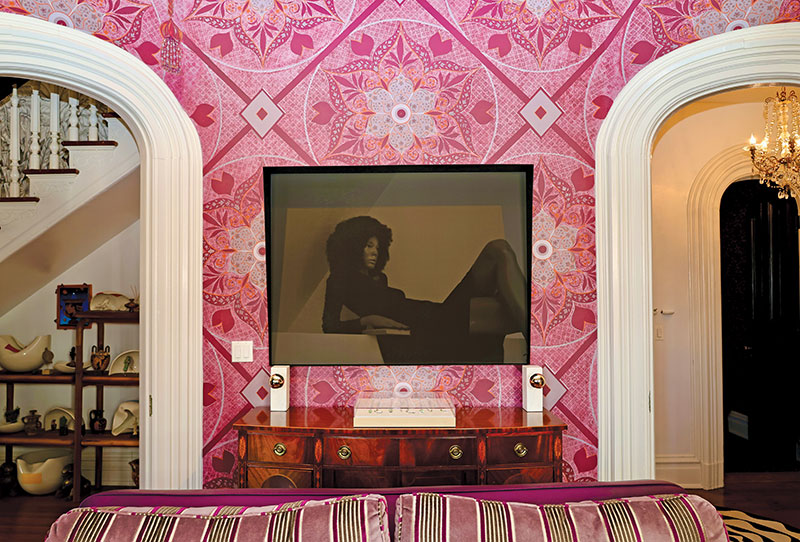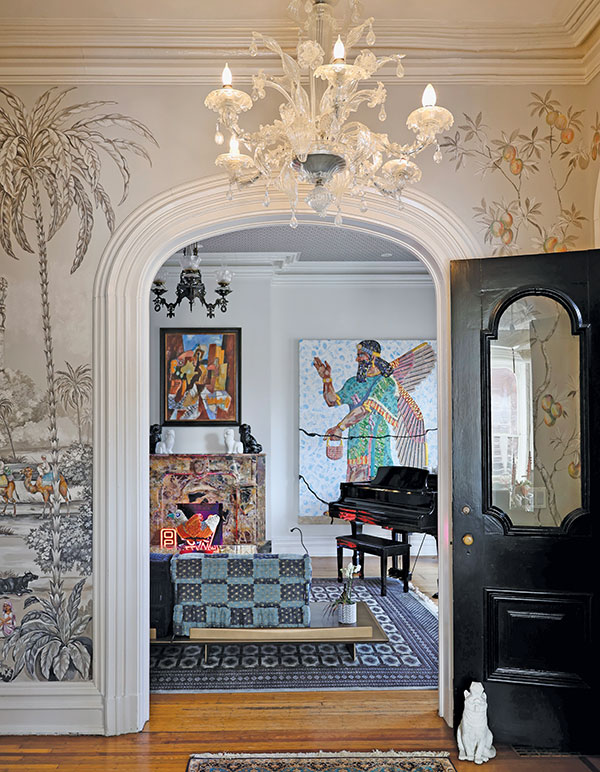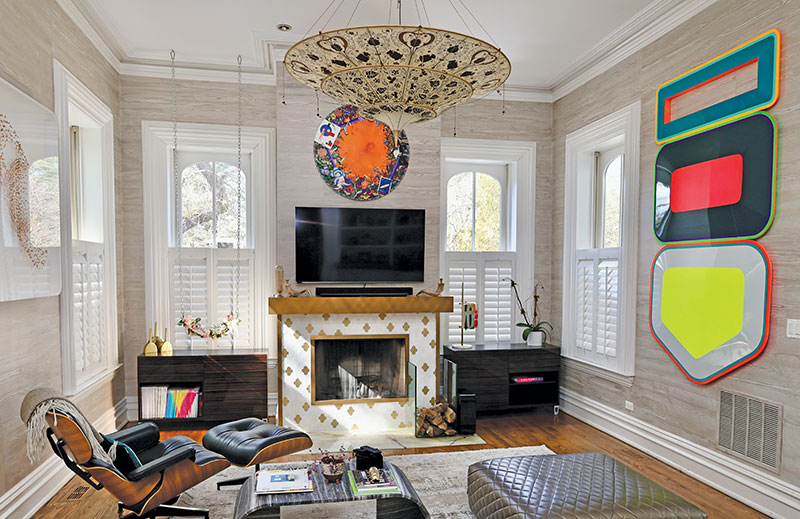A Living Collection: Sundeep Mullangi and Trissa Babrowski Support Their City Through Art


By BIANCA BOVA
Stepping into Trissa Babrowski and Sundeep Mullangi’s home for the first time is an unforgettable experience. Situated on a quiet block in Chicago’s Kenwood neighborhood, the Italianate Victorian house’s rather staid exterior belies the profusion of color, pattern, and artwork that greets visitors as soon as they cross its threshold. Upon entering it is immediately evident that each element has been thoughtfully selected and flawlessly integrated into a truly original environment reflective of the shared vision of its two creators, and the culturally and socially rich life they have built there.
Babrowski, a vascular surgeon, and Mullangi, the head of fixed income research at an investment management firm, met as students at Illinois Wesleyan University. While art collecting has always been a shared endeavor, their personal interests in art were developed independently. For Mullangi, it came about through an internship at the McLean County Arts Center in Bloomington, Illinois during college.
“They needed to digitize their financials, and I was hired as an intern to input all their paper records into QuickBooks. One day, I got out of the back room and walked around, and I realized how incredible the place was. I started working there on Saturday afternoons, because they needed someone to open the doors. That’s when I started meeting artists and saw the process of putting together the shows. That was my first real foray into art, and I loved it,” he explained.
For Babrowski, her explorations began at an earlier age. “When I was a child–probably five or six–my local public library had a lending program that allowed you to check out small reproductions of art masterpieces. There was an old pegboard wall full of all these little reproduction oil paintings, in this industrial brutalist-like library setting. I remember looking up at that and being overwhelmed by the amount of beauty contained in that space. I thought it was the most remarkable thing, that you could have an actual piece of art, and that it was something that could change according to your mood or whims. It had this transient, really beautiful quality about it,” she noted, before adding with a laugh, “My sister and I shared a bedroom, and we’d have competing walls and argue about whose installation looked better.”

The house itself, which the couple shares with their three sons, who range in age from eleven to sixteen, bears a certain historical importance to the neighborhood. Built in 1873, it is the oldest residence in Kenwood, and one of only a few remaining wooden houses in the city. Having been constructed prior to the annexation of Hyde Park and Kenwood by the city, it was not subject to the ban on such construction materials that was implemented in the wake of the Great Chicago Fire.
Inside, its Victorian character remains legible in the high ceilings, tall windows, grand fireplaces, and washes of sunlight that fill the rooms on the ground floor.
“We want the architecture, and the bones of the house, to be able to speak for themselves,” Babrowski says, “I think there’s something unexpected and something really fun about having very contemporary art within this setting. Houses aren’t static and houses shouldn’t be museums; they shouldn’t be strictly adherent to their past. They grow and evolve, just like any sort of living creature does.”
Mullangi adds, “Trissa has an incredible eye, and we’ve created this kind of layering. Art on top of wallpaper, wallpaper on ceilings, rugs we’ve hand-picked from all over the world, which has been fun as well, when we travel. The house is a visual memory of our life together. It is very much a family home, and we enjoy having people over, sharing the space, and opening people’s eyes to living with art in a way that maybe they haven’t seen in the past.”
One especially striking element is a mural by Patrick Roullier that begins just past the entrance of the home and extends along the two walls that follow the primary staircase up to the second floor. With its lush depictions of the flora, fauna, and landscapes of India in a muted palette, one could easily be forgiven for mistaking it for vintage wallpaper at first glance.

“I imagined what the people who built the house in 1873 might have covered these walls with”, says Babrowski, of the mural, “During that time those who were fortunate enough to go on grand tours of Europe, often returned home with these beautiful painted wallpaper panels. I thought about how we could update that idea, and make it relevant for us. So it’s these scenes from India that are particularly important to us. Sundeep’s family had mango plantations, and so the mango tree motif is an essential element of the design. It was a way to stay in keeping with the house but still, at the same time, make it modern and fresh and a backdrop for our life as a family.”
Art can be found in nearly every room of the home, with works by artists ranging from Derrick Adams, Bethany Collins, Julien Creuzet, Beverly Fishman, Vanessa German, and Jeffrey Gibson, to Claire Sherman, SoiL Thornton, Martha Tuttle, Kehinde Wiley and Jonas Wood. Chicago artists are also well-represented in the collection, including Dabin Ahn, Roger Brown, Theaster Gates, Jeremiah Hulsebos-Spofford, Judy Ledgerwood, Laura Letinsky, Angel Otero, Jason Pickleman, Michael Rakowitz, Tony Tasset, and Amanda Williams, among others.
“Organic while simultaneously intentional, our collection serves as an ongoing love letter to Chicago. We believe in fostering a rich arts ecosystem as philanthropists and patrons, convinced that a vibrant cultural milieu is the most effective mechanism to facilitate societal change and evolution. We consider ourselves keepers of this art rather than collectors, and especially seek to support the stories and practices of artists traditionally excluded from the historical cannon. While objecthood is central to any collection, we are most interested in how art serves as a vehicle for bridging cultural divides.”
- Trissa Babrowski & Sundeep Mullangi
“It’s not that we don’t go outside of Chicago to buy art, because we absolutely do,” says Mullangi, “but we really believe in supporting the art community here, both artists and galleries. We’re not just buying art to own it, to possess it, we’re buying art to be supportive of this whole ecosystem that it all rests upon. We’ve always had the feeling of, ‘If not us, then who’s going to do that?’ Because you need the support of the people who are embedded here to really make a difference.”
For the couple, that support extends well beyond art collecting. Both are also active philanthropists and supporters of many cultural and educational organizations in the city.

“I’m passionate about volunteer work,” says Mullangi, “I serve on boards at the University of Chicago, through the Lab School; at the Hyde Park Arts Center; and at Illinois Wesleyan University. I really like to be at the intersection of community, education, and art. I find that these three institutions are right at that intersection, trying to help develop programs and leadership and see what the way forward looks like.
I grew up in Macomb, Illinois. It was classic small town USA. When I was in high school, it was all about sports, it was about football. It was about Friday night games, and varsity letters, and wearing your sports jacket, and then potentially giving that jacket to a girlfriend,” continues Mullangi, “We all grew up with that being the norm, that’s just what you do, but in the art world you don’t do that. You don’t get a varsity letter for painting well. I’ve always wanted the equivalent memento available for artists, to make the way we emphasize art in our culture not so dissimilar to how we emphasize sports. The Hyde Park Arts Center especially does a phenomenal job in this way, with their fundraising to allow individuals, both kids and adults, the ability to take classes for free, or for whatever they can pay. That work I’m so proud of to be a part of, because that is what we need to do much more of. In Chicago, in other urban areas, we need to allow individuals to find their niche, and, importantly, to then go figure out how to improve upon that. Then maybe they’re on their way to do something pretty significant.
Trissa, as a surgeon, she helps people every day in ways that literally change their lives. My professional life is much different, so I’ve tried to effect change in an alternative way,” he adds, “What Trissa does is also actually very creative, and beautiful too. Of course, we don’t all get to see it, because all of her work is inside the body.”
“As a vascular surgeon, what I do does involve a lot of creativity,” Babrowski says, “You have an area that’s diseased, and you have to figure out a way to circumvent that. I always tell the residents, ‘it has to be perfect and it has to be beautiful, and unless it’s beautiful, it doesn’t count.’ I think that’s also kind of evocative throughout our collection as well. There’s a lot of what might be called traditional women’s work in it. I think women’s creativity, the way that women express themselves, has traditionally been undervalued. Everybody deserves to be seen and felt and heard, and through the collection we try and ensure that’s true because everybody has creativity, it’s just about the way that you express it. And that’s different for everybody.”

In bringing these creative voices together in their collection, Babrowski and Mullangi create space for dialogues to develop between the works themselves, which in turn have the ability to spark meaningful conversations between their viewers.
“Clearly there are a lot of problems within the world today. I think art gives us a language and an opportunity to think about it, and have civil discourse about issues that may not be so easy to talk about,” says Babrowski, “Simply having the opportunity to look sometimes gives you greater compassion and understanding of other people’s perspectives.”
Many are fortunate enough to have that opportunity, as Babrowski and Mullangi’s hospitality is well-known. Gatherings of family, friends, and artists, along with social events for the art community are frequent occurrences in their home.
“I always say when the house is full, there is a very particular vibe. It almost feels like the house itself is happy to be full of people,” says Babrowski.
Their generosity extends beyond making the collection accessible through visits and parties, as the couple are frequent lenders to institutional exhibitions as well.
“I think it’s the saddest thing when a work disappears into a private collection, and nobody else gets to see it,” says Mullangi.
“Artists do this incredible work–and incredibly important work–where they’re translating a message into a visual medium, and that should be shared and projected, and shouldn’t just live in isolation for only a handful of people to see, in our opinion,” adds Babrowski, continuing, “We’re fortunate that we’re able to acquire these works, and that we are their caretakers. But, just as with this house, we really feel that we’re just their guardians for a period of time. You know, the human lifespan is very short. We aren’t going to be the ones who have any of this for that long of a time, really. In the meantime, why not share that with people while we’re still able to, and while we’re here to enjoy that as well?”
#
To read more about collecting what you love, click here.
This interview is featured in the spring/summer 2024 issue of CGN. To subscribe to the print edition click here.






